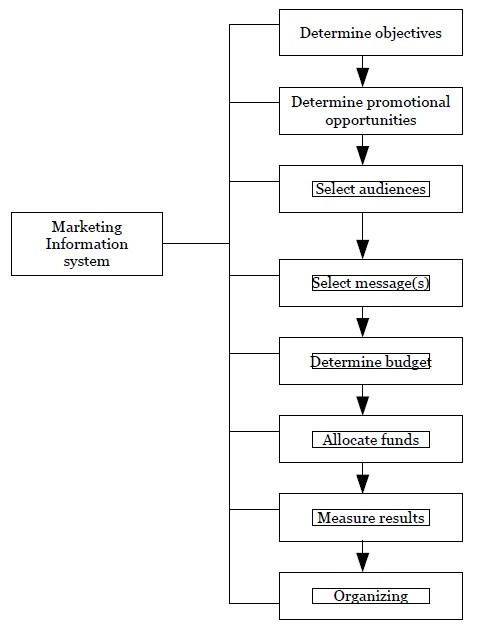The design of an effective IMC strategy is a very difficult and time-consuming process that requires the efforts of many members of the marketing staff. Although there has been a great deal of variety in designing this process, the steps depicted in Figure 8.3 are most common.

As is the case with most marketing activities, IMC is guided by a set of objectives. There are numerous responses that the manager may desire from his IMC effort. Although the ultimate buyer behavior desired is product purchase, several intermediate responses may prove important as well. Examples of these intermediate responses are shown in Figure 8.4.

If there is a marketing opportunity, there must also be a communication opportunity. Although the role of IMC is de-emphasized in certain marketing programs, there will also be some communicative, motivational, or competitive tasks to be performed. Whether or not the marketing programs should rely heavily on its communication ingredient to perform such tasks depends upon the nature and extent of the opportunity. There are several conditions which, if they exist, indicate a favorable opportunity to communicate: for example, it is always easier to communicate effectively when moving with the current consumer demand rather than against it. Companies such as IBM have been actively promoting their business computers, which are increasing in popularity, rather than home computers, which are not doing as well.
The third consideration is selecting the target audience for the IMC. This is undoubtedly the most important factor in the IMC strategy, yet it is probably the issue that many companies slight or overlook entirely. Marketing messages must be directed at the specific target for which the overall marketing program is being designed. However, very seldom is there a single group of consumers at which to direct promotion. Many individuals affect the buying process, and the IMC program must be designed to reach all of them. In addition to the primary purchasers and users of the product, individuals who influence the purchase decision must also be considered. For example, consumers usually rely heavily upon the assistance and advice of others in purchasing such products as automobiles, interior decorating, major appliances, and physicians, to name but a few. Similarly, industrial buyers consider the advice of engineers, technicians, and even competitors. Thus it is extremely important in resolving the communication issue to identify accurately not only those who consume and buy the product but also those who influence its purchase.
Determining exactly what to say to the relevant audience is the fourth consideration. The heart of IMC is the transmission of ideas of marketing significance to the seller. Whether these ideas are received and perceived as intended depends in large part on the skill used in developing the communication appeal. It also depends upon the vehicle used to deliver the message. Whether it is the message delivered by a salesperson, a newspaper, or a point-of-purchase display, the message must facilitate reaching the communication objectives.
Money is always an important factor; a typical IMC effort is extremely expensive and is becoming more expensive every day. Keeping track of these cost elements is a full-time job. The budget for a particular IMC effort can be determined through very sophisticated computer programs or through intuitive techniques such as experience, following competition, or simply spending all you can afford. Particular budgetary approaches are summarized in Table 8.1.
| Technique | General description |
|---|---|
| Arbitrary allocation | Management bases budget on personal experience, business philosophy, and marketing intuition |
| Affordability | Upper limit of budget based on available company resources |
| Ratio-to-sales | Amount budgeted is based on some portion of past or forecasted sales |
| Competitive comparisons | Budget based on amount being spent by major competitors |
| Experimental approach | Budget based on test market results |
| Objective-task method | Determine costs of reaching specific promotional objectives and sum amounts |
Once you decide how much to spend, the amounts to be spent on personal selling, advertising, publicity, and sales promotion must be decided. After determining the major allocations, each of these figures must be broken down into much finer increments. For example, the advertising budget must be reallocated by media category, then by specific media, and finally, by particular dates, times, issues, etc.
Evaluating the effectiveness of an IMC effort is very important. Three tasks must be completed when one attempts to measure the results of IMC. First, standards for IMC effectiveness, such as retention and liking, must be established. This means that the market planner must have a clear understanding of exactly what the communication is intended to accomplish. For measurement purposes, the standards should be identified in specific, quantitative terms. Second, actual IMC performance must be monitored. To do this, it is usually necessary to conduct experiments in which the effects of other variables are either excluded or controlled. The third step in measuring IMC efficiency is to compare these performance measures against the standards. In doing so, it is theoretically possible to determine the effective methods of marketing communication.
Finally, how a company organizes for IMC depends on the degree to which it desires to perform the communication function internally or to assign this task to outside agencies. Typically, the sales function is performed internally and the sales organization is a part of the overall, standing organizational plan. Occasionally, as when manufacturer's agents are used, outside organizations are employed to perform personal selling. Advertising services might be performed internally or externally. Sales promotion activities are usually also handled internally, although it is not uncommon for advertising agencies to be consulted in connection with sales promotion plans. The same is true for public relations.
- 3776 reads






